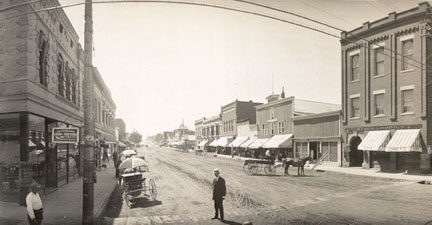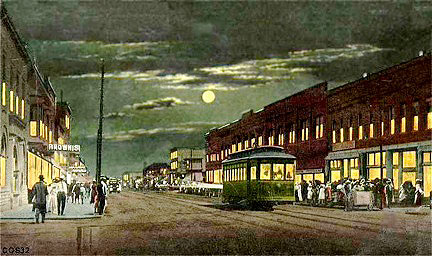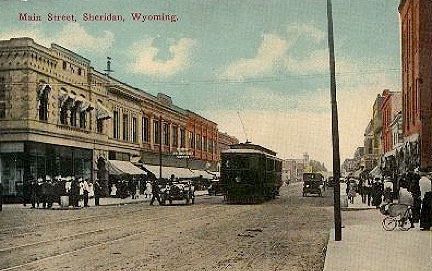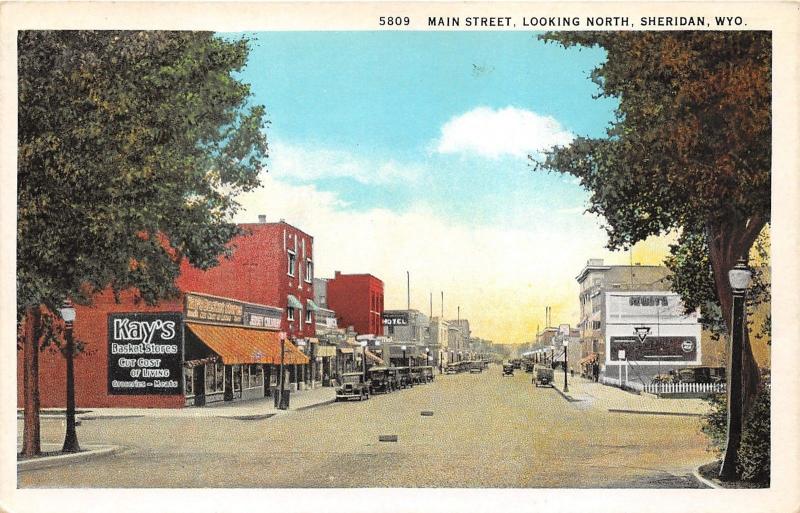-----
 |
| Sheridan in 1909, prior to the streetcar installation. (Wyohistory.org) |
Sheridan, WY, lies 13 miles south of the Wyoming-Montana border within the same-named county. The town site was first inhabited in 1878 by trapped George Mantel, but the town would be officially established in 1882 and named after Civil War General Philip Sheridan of the Union Army. In the early days, railroad commerce fueled the small town thanks to the Burlington & Missouri Railroad (B&M, now Burlington Northern Santa Fe), but it was the discovery of rich coal mines that boosted Sheridan's status as a mining boomtown. By 1910, where this story begins, Sheridan boasted 18,000 citizens, but no train service to and from the mines.
 |
| Burlington and Missouri Railroad No. 120 in Broken Bow, Nebraska, 1886. (Library of Congress) |
In 1910, two men from Dayton, Ohio named Albert Emanuel and William Sullivan, proposed giving Sheridan its own streetcar system that would also provide interurban service from the town to the mines, the only one in the state. Unlike the hornswoggling committed in Laramie, the city fathers trusted Emanuel and Sullivan enough to approve their proposal and contruction began on July, 11, 1910, finishing just a year and a month later on August 11 with a single line down Main Street from the Burlington & Missouri depot.
 |
| A colorised image of Sheridan at night, with a tiny "Rubber Stamp" heading away. (Wyohistory.org) |
The new company, the Sheridan Railway & Light Company, was a welcome modernization to the town and on opening day, many crowded the streets to gaze at the new trolley cars. Three would be delivered that opening day from American Car Co. and came to be known as "rubber stamps" due to the short shape resembling a traditional stamp applicator. Car 10 would be draped in a fashionable banner reading "The Buisness Mens Club" as she rolled down Main Street, but nobody would bother to correct the spelling or grammar errors.
 |
| Guys, this is literally what my editor is here for. (Downtown Sheridan) |
The Main Street alignment would be known as the City Line, and after a successful operating period of five days, a second line would open dubbed the "Fort Line." This extension ran up Main Street and over Lewis Hill to the Sheridan County Fairgrounds, before heading out to Fort MacKenzie, a US Army outpost established in 1898. With two trolley lines operating at peak capacity over five streetcars, it was now time for an interurban line.
 |
| Sheridan's swanky interurban cars by American Car Co. of St. Louis, photographed October 1911 (Bill Volkmer) |
Dietz was located five miles north of Sheridan, with the line north following the B&M's mainline out to Montana. The mine entrance was too far for the railroad to change its alignment, so the interurban was built to haul workers to and from the mines much more conveniently. The route would add another 12 miles to the Sheridan system and large wooden interurbans from American Car to the boomtown's fleet.
 |
| Another postcard shot of 1912, showing the Mine Interurban on Main Street, looking North. (Wyohistory) |
 |
| A Main Street Postcard of Sheridan in the late 1920s, showing a distinct lack of trolley track or wire. (HipPostcard) |
March 1924 would see the Fort Line give up the ghost when it was replaced by bus service, and the Mine interurban would be abandoned in 1926, giving it the distinction of being the last electric railway in the state of Wyoming. Though Sheridan continues today as a quiet little mountain town full of buses, the Sheridan Electric Lives on when the body of city car 115 (itself an original American Car Co. product) was found lying in a field. Today, the Sheridan County Museum has the car plinthed outside their location where it was first restored in 1976.
 |
| Sheridan Electric and Light Co. No. 115, the last trolleycar in Wyoming. (The Sheridan Press) |
Car 115 underwent a quick restoration for America's bicentennial, including slipping two AAR freight trucks below its original steel frame. Today, the Sheridan College Welding Department and the Sheridan County Museum are working to make a new steel base to sit the original body on (complete with facsimile wheels) and give the 115 a new lease on life.
-----
Thank you for reading today's Trolley Tuesday postings! As a minor surprise, this is the last episode in March as we've... run out of content, so Thursday will be have no postings. Fret not, however! Starting March 31, we move over to our next state: Colorado! You won't believe how much trolley content we get to mine from there! Until next time, follow myself and my editor on Twitter, go buy a shirt, and ride safe!

No comments:
Post a Comment